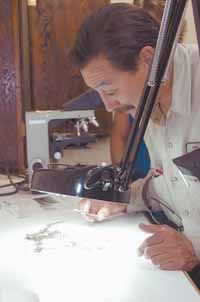| Pat Vigil examines the mosquitos caught in a trap Monday.The county mosquito abatement department employee has been trained in the process of identifying the types of the insects known to carry the west Nile virus. |
On Monday afternoon, a Carbon County vehicle maneuvered along a bumpy road through washouts created by irrigation water from a farmer’s field.
“This is where we put the traps for the mosquitos because the irrigation runoff pools down here,” explained county abatement department worker Pat Terrell. “We need to put on some repellent before we go down in there.”
After applying the spray, Terrell unloaded metal poles, a hammer and a cylinder that contained dry ice attached to a mesh bag.
The county mosquito abatement department employee traversed a fence and walked through a field with dozens of small rivelets of water.
Within seconds, a cloud of mosquitoes descended on the county worker.
“This is the kind of place we will eventually find them,” noted Terrell as he pounded the poles into the ground. He was referring to the mosquitoes that can carry the west Nile virus.
Terrell fitted the pole with a holder and battery. The abatement worker hung a hook on top and attached the cylinder.
“This trap is filled with dry ice because the CO2 attracts the mosquitoes,” he explained as he hooked up the fan to the battery. “The fan sucks them into the mesh trap and then we gather them up to examine them.”
Terrell headed out of the area as the mist of insects dispersed.
“I’ll pick up that trap tomorrow morning and then we’ll take them to the lab to check out what we have caught,” pointed out the county mosquito abatement worker.
The tasks completed by Terrell are important to the interagency effort to determine when the west Nile virus may invade Carbon County.
Carbon County crews are trapping mosquitoes and looking for certain types of the insects. The crews are also keeping a close eye on a sentinel bird station in the southern part of the county where chickens are located.
Research has found that chickens get infected quickly by the disease, and each Monday morning the birds are checked for signs of the virus.
The Utah Department of Wildlife Resources has a specialist who is visitng locations where dead wild birds are reported. The DWR specialist is trained to examine and test the dead birds for the disease.
But not all birds are susceptible to the virus. Experts indicate that the division is specifically looking for corvids (crows, ravens, magpies) and raptors.
In addition to the county and DWR, the Southeastern Utah Health District is monitoring what the agencies are doing. The district is also monitoring the health of residents along with providing public educational materials.
On Tuesday, Terrell picked up the trap containing hundreds of dead mosquitos.
In a laboratory prepared during the last couple of weeks, Terrell and fellow county abatement department employee Pat Vigil started to sort through the insect specimens.
The lab, a former storeroom located in the back of a department shop, is still filled with storage, with the exception of one wall.
A table is situated next to the wall with drawings of seven different types of mosquitos.The table has a lighted magnifier along with a fairly powerful microscope.
“We have to get to these quickly or they start to deteriorate,” explained Terrell, using a magnifier to examine the insects.
Terrell pointed to the posters on the wall and explained what they were looking for.
In the magnified drawings, there are significant differences between the types of mosquitoes. But identifying the differences is a difficult chore, even looking at the insects through the magnifier.
“We took some training on this a few weeks ago and one of the experts there could have looked at these without any magnification and told us which were which,” said Terrell.
Vigil was examining the pile of dead insects on the table through the lighted magnifier.
“They detected the disease in birds in Grand Junction along the Colorado River last fall before it got cold,” noted Vigil. “So it came fairly close then. This year, so far they haven’t found it there, but it is probably just a matter of time.”
The two county abatement department employees examined the contents of the trap and compared the differences in body types of the dead insects with the posters.
“See this – the type we are looking for has a different body and often has white marks on it’s legs,” pointed out Terrell. “The disease also affects the legs of the ones that have it. They tend to fall apart quickly.”
West Nile virus surfaced approximately four years ago in New Jersey. Since then, the virus has been carried across the nation from ocean to ocean.
According to experts, only four states, including Utah, have not identified the disease in mosquitos or sentinel birds.
“In the last couple of weeks, everyone seemed so concerned about the moths around town,” Terrell stated. “They wanted us to come spray them, but they were little threat to anything or anybody. This is more serious.”
Obviously, this job puts the county workers at risk for getting the virus. Crews go into infested areas to gather samples and even with safety measures get bit.
“That biting part that people talk about isn’t factual,” pointed out Vigil. “They don’t bite or inject, but use chemicals from their bodies to draw blood up through the skin. That’s how the disease passes.”
The testing on the mosquitos and chickens each week will continue until the disease shows up in the area.
“Once we find that it is here, this testing will all end,” concluded Terrell.
This is when residents need to adhere to the precautions set forth by the health department.

